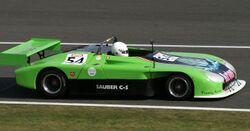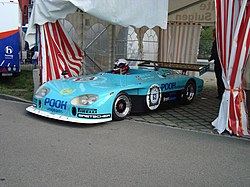Engineering:Sauber C5
From HandWiki
Short description: Racing automobile
| Category | Group 6 | ||||||
|---|---|---|---|---|---|---|---|
| Constructor | Sauber | ||||||
| Production | 1975-1978 | ||||||
| Predecessor | Sauber C4 | ||||||
| Successor | Sauber SHS C6 | ||||||
| Technical specifications | |||||||
| Chassis | Aluminum Monocoque covered in Fiberglass panel body | ||||||
| Suspension (front) | Double wishbones, Coil springs over Dampers, Anti-roll bar | ||||||
| Suspension (rear) | Twin lower links, Single top links, twin trailing arms, Coil springs over Dampers, Anti-roll bar | ||||||
| Axle track | 1,470 mm (58 in) (front) 1,450 mm (57 in) (rear) | ||||||
| Wheelbase | 2,420 mm (95 in) | ||||||
| Engine | BMW M12, 2.0 L (122.0 cu in), L4, NA | ||||||
| Transmission | Hewland FGA 400 5-speed manual | ||||||
| Power | 300 hp (224 kW) | ||||||
| Weight | 630 kg (1,390 lb) | ||||||
| Competition history | |||||||
| Debut | 1975 | ||||||
| |||||||
The Sauber C5 is a Group 6 prototype racing car, designed, developed and built by the Swiss Sauber team, specifically made to compete in the 1977 24 Hours of Le Mans and the 1978 24 Hours of Le Mans. It is powered by a naturally aspirated 300 hp (220 kW) BMW M12 four-cylinder engine. It scored 15 race wins, 31 podiums, clinched 1 pole position, and 6 wins in its class. With these statistics, it makes it one of the most successful early Sauber sports cars.[4][5][6][7][8][9][10]
References
- ↑ "1976 - 1978 Sauber C5 BMW - Images, Specifications and Information". https://www.ultimatecarpage.com/car/5515/Sauber-C5-BMW.html.
- ↑ "Sauber C5". https://www.racingsportscars.com/type/Sauber/C5.html.
- ↑ "Sauber C5 group 6 (1975) - Racing Cars". http://tech-racingcars.wikidot.com/sauber-c5.
- ↑ "Peter Sauber: Vom C1 zum C22". https://www.handelszeitung.ch/unternehmen/peter-sauber-vom-c1-zum-c22.
- ↑ "History and Heritage". https://www.sauber-group.com/corporate/history/.
- ↑ Engineering, Racecar (July 19, 2010). "40 years of Sauber Motorsport". https://www.racecar-engineering.com/articles/40-years-of-sauber-motorsport/.
- ↑ "Sauber's half centenary". May 11, 2020. https://www.historicracingtechnology.com/2020/05/saubers-half-centenary/.
- ↑ The Fastest Show on Earth: The Mammoth Book of Formula 1. Little, Brown Book Group. September 3, 2015. ISBN 9781472110527. https://books.google.com/books?id=3udeBwAAQBAJ&dq=sauber+c1&pg=PT183. Retrieved June 17, 2022.
- ↑ "Peter Sauber biography". https://www.historicracing.com/driverDetail.cfm?driverID=7630.
- ↑ Shah, Kunal (June 29, 2020). "Peter Sauber Interview On 50 Years In Motorsport". https://www.kunalsf1blog.com/peter-sauber-50-years-motorsport/.
 |



